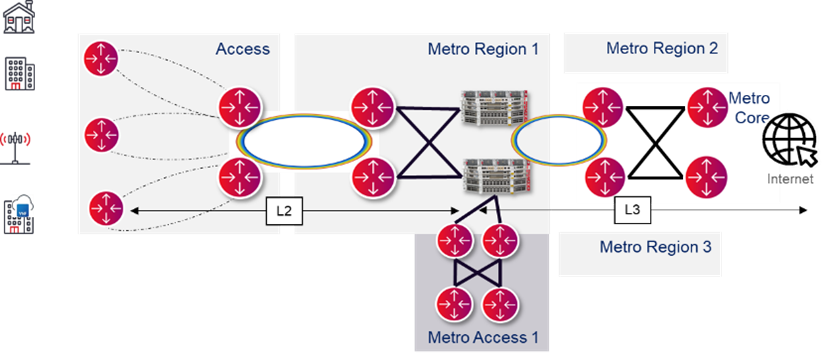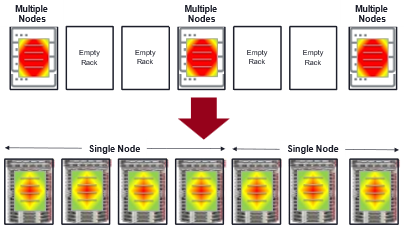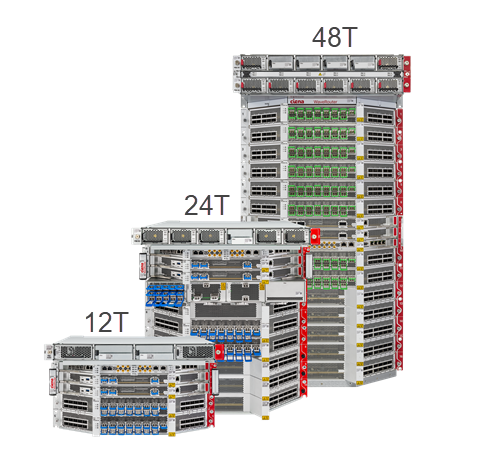The WaveRouter family is getting bigger, by going smaller. Ciena’s Joe Marsella explains how you can now get the benefits of WaveRouter in more capacities and form factors to converge your metro networks.
Last year we launched WaveRouterTM, an industry-first platform architecture, allowing you to break away from legacy constraints to converge IP and optical layers with ultimate operational simplicity, future-proof scale, and improved sustainability.
WaveRouter brought to the industry advanced IP routing architecture principles, packaged with a new platform architecture design, industry leading Ciena WaveLogicTM coherent optics, and multi-layer network visibility and software control. And last week, we shared that Verizon will continue to evolve its long-haul and metro network utilizing WaveRouter along with other Ciena solutions.
But our teams didn’t stop there and continued to develop options to bring these benefits to more customers’ networks.
Meet the expanded WaveRouter family: WaveRouter-2, WaveRouter-7 and WaveRouter-13
WaveRouter Family: The previously introduced WaveRouter-13,
along with the new WaveRouter-2 and WaveRouter-7
To provide the critical flexibility our customers require, while understanding not all networks are the same, we are taking a ‘no one size fits all approach’ by offering an expanded range of WaveRouter options with the new WaveRouter-2 and WaveRouter-7, to better support your network convergence needs.
Why more choices? We heard directly from customers that you need flexibility when deploying technology for different locations, use cases, and capacity needs. For instance, some of our customers may never need the 192TB of scaling capacity introduced with WaveRouter-13 in their network. They can benefit from smaller form factors of WaveRouter.
The good news about the expanded WaveRouter family is it continues to bring together flexible scale, integration of performance optics, and a distributed architecture, with full L0 to L3 convergence, but in your choice of size to meet your business needs. Each WaveRouter variant offers metro network operators the freedom to build to scale—today and tomorrow—with extensible switch fabric and flexible cabling options.
The previously introduced WaveRouter-13 (WR-13) housing provides flexibility of up to 48Tb/s of capacity. Now, by expanding the family there are more options, the WaveRouter-7 (WR-7) housing provides up to 24Tb/s of capacity and the WaveRouter-2 (WR-2) housing has up to 12TB/s of capacity. All these provide greater choice in how you support different use cases in your network.
After bringing to market last year WaveRouter-13, a 48Tb/s coherent metro router, Ciena’s back at it again with two new form factors—a strategic move that will enable the company to serve a wide range of customer applications. The new 12Tb/s and 24Tb/s housings provide more choices to converge the metro and expand WaveRouter’s market penetration.
Just like the original WaveRouter, the expanded family will help our customers meet the vigorous demands placed on their networks, while at the same time delivering the ability to eliminate trade-offs in space, power, cooling, and scalability. With WaveRouter, we are delivering a reimagined routing platform designed with multi-layer control, leveraging Navigator Network Control Suite’s single point of control and visibility, so operators can cost-effectively converge the IP and optical layers of their networks.
Let’s take a deeper look at the demand drivers and leading use cases for our newest form factors, WR-2 and WR-7.
The driving demands for more choice
Enterprise and service providers want to expand their service offerings geographically but traversing different metropolitan area networks (MANs) can be extremely challenging if not impossible. Since L2 switches have no routing capabilities, switching between different network segments by stitching virtual local area networks (VLANs) together can be done but will never scale for any metro network.

L3/L2 multi-service PE Large Metro with the WaveRouter Family
We went to work to help with that. Now you can pick your WaveRouter size (12Tb/s, 24Tb/s, or 48Tb/s) and interconnecting L2 services with L3 services across multiple regions can be accomplished with the click of a mouse.
Next, let’s look at mobility and fixed access services traffic. Mobile operators are often challenged having to connect multiple metro networks together with DWDM and connecting other vendors OTN cross-connects with high-performance transponders. WaveRouter can backhaul traffic from multiple remote access services to the metro using EVPN VPLS/VPLS for enterprises and L3VPN/VRF for mobility and fixed access services.
Again, simply pick your choice of our WaveRouter and you can have all the benefits of a coordinated multi-layer approach in a single device, removing the cost of maintaining multiple devices, while reducing footprint.

L3 aggregation for mobility/fixed access
Let’s talk about the Wholesalers next. Their success is based on providing shared communications infrastructure, as well as connecting data centers, Points of Presence (PoP), Central Offices (COs), and lit buildings. International wholesalers provide the same connectivity, but for regional and national metro networks with shared communications infrastructure – having to deploy multiple devices. WaveRouter’s family of routers eliminates the need to deploy multiple devices (router + transport) by having the unheard-of ability of having performance optics in a metro router and simplified multi-layer convergence without stranding chipset or fabric capacity.

CSP Wholesale
And finally, Managed Service Providers (MSPs) are evolving to multi-layer convergence and require adequate building load and thermal and cooling capabilities. With the plan to introduce IP/Optical convergence (aka coherent routing), they can densely pack one rack but may have to leave adjacent racks empty or may have to reinforce the floor because the building is a hundred years old. One advantage of the WaveRouter family is the ability to support both full-fill pluggable and performance coherent optics, as well as physically distribute a single node to spatially distribute thermal footprint. With three WaveRouter options, operators now have more choices when going from 100G to 400G to 800G and even to 1.6T.

Thermal spatial density
More choices for your metro network
To sum it all up, the WaveRouter family was designed to address a range of critical use cases operators are dealing with every day in their networks. By expanding the WaveRouter family our goal is to address these use cases by offering more choices (WR-2, WR-7, and WR-13) to converge your network, Ciena is helping operators easily build and manage converged networks with optimized performance. The result – highly efficient, scalable, and sustainable networks that are ready to dynamically adapt to market demand.







